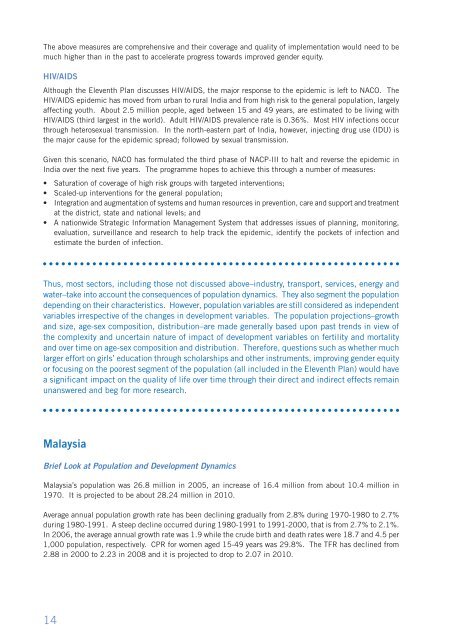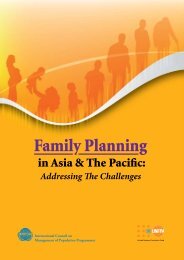Inter-lInkages between PoPulatIon DynamIcs anD DeveloPment In ...
Inter-lInkages between PoPulatIon DynamIcs anD DeveloPment In ...
Inter-lInkages between PoPulatIon DynamIcs anD DeveloPment In ...
Create successful ePaper yourself
Turn your PDF publications into a flip-book with our unique Google optimized e-Paper software.
The above measures are comprehensive and their coverage and quality of implementation would need to bemuch higher than in the past to accelerate progress towards improved gender equity.HIV/AIDSAlthough the Eleventh Plan discusses HIV/AIDS, the major response to the epidemic is left to NACO. TheHIV/AIDS epidemic has moved from urban to rural <strong>In</strong>dia and from high risk to the general population, largelyaffecting youth. About 2.5 million people, aged <strong>between</strong> 15 and 49 years, are estimated to be living withHIV/AIDS (third largest in the world). Adult HIV/AIDS prevalence rate is 0.36%. Most HIV infections occurthrough heterosexual transmission. <strong>In</strong> the north-eastern part of <strong>In</strong>dia, however, injecting drug use (IDU) isthe major cause for the epidemic spread; followed by sexual transmission.Given this scenario, NACO has formulated the third phase of NACP-III to halt and reverse the epidemic in<strong>In</strong>dia over the next five years. The programme hopes to achieve this through a number of measures:• Saturation of coverage of high risk groups with targeted interventions;• Scaled-up interventions for the general population;• <strong>In</strong>tegration and augmentation of systems and human resources in prevention, care and support and treatmentat the district, state and national levels; and• A nationwide Strategic <strong>In</strong>formation Management System that addresses issues of planning, monitoring,evaluation, surveillance and research to help track the epidemic, identify the pockets of infection andestimate the burden of infection.○ ○ ○ ○ ○ ○ ○ ○ ○ ○ ○ ○ ○ ○ ○ ○ ○ ○ ○ ○ ○ ○ ○ ○ ○ ○ ○ ○ ○ ○ ○ ○ ○ ○ ○ ○ ○ ○ ○ ○ ○ ○ ○ ○ ○ ○ ○ ○ ○ ○ ○ ○ ○ ○ ○ ○ ○ ○Thus, most sectors, including those not discussed above–industry, transport, services, energy andwater–take into account the consequences of population dynamics. They also segment the populationdepending on their characteristics. However, population variables are still considered as independentvariables irrespective of the changes in development variables. The population projections–growthand size, age-sex composition, distribution–are made generally based upon past trends in view ofthe complexity and uncertain nature of impact of development variables on fertility and mortalityand over time on age-sex composition and distribution. Therefore, questions such as whether muchlarger effort on girls’ education through scholarships and other instruments, improving gender equityor focusing on the poorest segment of the population (all included in the Eleventh Plan) would havea significant impact on the quality of life over time through their direct and indirect effects remainunanswered and beg for more research.○ ○ ○ ○ ○ ○ ○ ○ ○ ○ ○ ○ ○ ○ ○ ○ ○ ○ ○ ○ ○ ○ ○ ○ ○ ○ ○ ○ ○ ○ ○ ○ ○ ○ ○ ○ ○ ○ ○ ○ ○ ○ ○ ○ ○ ○ ○ ○ ○ ○ ○ ○ ○ ○ ○ ○ ○ ○MalaysiaBrief Look at Population and Development DynamicsMalaysia’s population was 26.8 million in 2005, an increase of 16.4 million from about 10.4 million in1970. It is projected to be about 28.24 million in 2010.Average annual population growth rate has been declining gradually from 2.8% during 1970-1980 to 2.7%during 1980-1991. A steep decline occurred during 1980-1991 to 1991-2000, that is from 2.7% to 2.1%.<strong>In</strong> 2006, the average annual growth rate was 1.9 while the crude birth and death rates were 18.7 and 4.5 per1,000 population, respectively. CPR for women aged 15-49 years was 29.8%. The TFR has declined from2.88 in 2000 to 2.23 in 2008 and it is projected to drop to 2.07 in 2010.14














